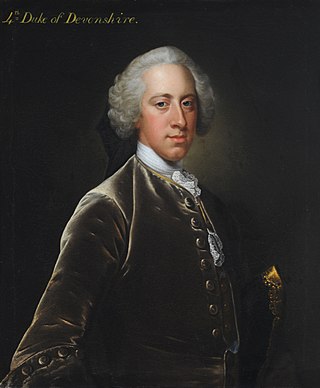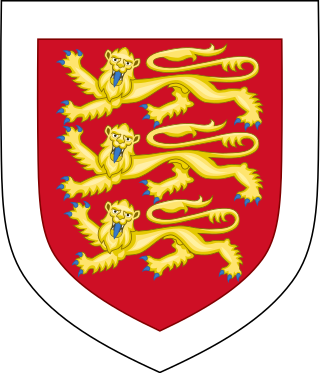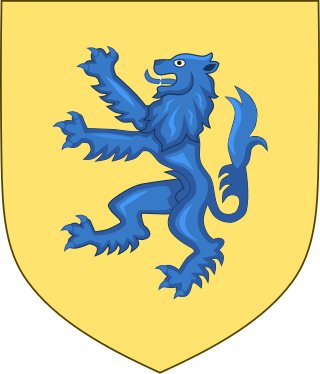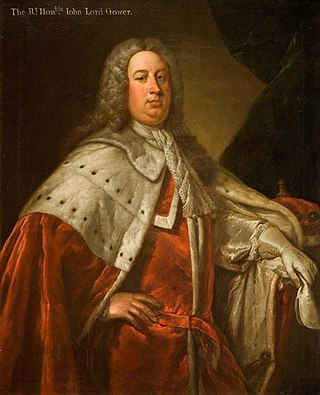Duke of Newcastle upon Tyne was a title that was created three times, once in the Peerage of England and twice in the Peerage of Great Britain. The first grant of the title was made in 1665 to William Cavendish, 1st Marquess of Newcastle upon Tyne. He was a prominent Royalist commander during the Civil War.

Henry Pelham was a British Whig statesman who served as Prime Minister of Great Britain from 1743 until his death in 1754. He was the younger brother of Thomas Pelham-Holles, 1st Duke of Newcastle, who served in Pelham's government and succeeded him as prime minister. Pelham is generally considered to have been Britain's third prime minister, after Robert Walpole and the Earl of Wilmington.

William Cavendish, 4th Duke of Devonshire,, styled Lord Cavendish before 1729, and Marquess of Hartington between 1729 and 1755, was a British Whig statesman and nobleman who was briefly nominal Prime Minister of Great Britain. He was the first son of William Cavendish, 3rd Duke of Devonshire and his wife, Catherine Hoskins. He is also a great-great-great-great-great-grandfather of King Charles III through the king's maternal great-grandmother.

Thomas Holland, 2nd Earl of Kent was an English nobleman and a councillor of his half-brother, King Richard II of England.

Henry Fox, 1st Baron Holland, PC was an English peer and Whig politician who served as the Secretary at War from 1746 to 1755. He also held the offices of Secretary of State for the Southern Department from 1755 to 1756 and Paymaster of the Forces from 1757 to 1765, enriching himself while holding the latter office. While Fox was widely tipped as a potential candidate for the office of Prime Minister, he never held the office. His third son was the Whig statesman Charles James Fox.

Duke of Northumberland is a noble title that has been created three times in English and British history, twice in the Peerage of England and once in the Peerage of Great Britain. The current holder of this title is Ralph Percy, 12th Duke of Northumberland.

Earl of Lincoln is a title that has been created eight times in the Peerage of England, most recently in 1572. The title was borne by the Dukes of Newcastle-under-Lyne from 1768 to 1988, until the dukedom became extinct.

Earl of Chichester is a title that has been created three times, twice in the Peerage of England and once in the Peerage of the United Kingdom. The current title was created in the Peerage of the United Kingdom in 1801 for Thomas Pelham, 2nd Baron Pelham of Stanmer.

The Lord Warden of the Cinque Ports is a ceremonial official in the United Kingdom. The post dates from at least the 12th century, when the title was Keeper of the Coast, but may be older. The Lord Warden was originally in charge of the Cinque Ports, a group of five port towns on the southeast coast of England that was formed to collectively supply ships for The Crown in the absence at the time of a formal navy. Today the role is a sinecure and an honorary title, and fourteen towns belong to the Cinque Ports confederation. The title is one of the higher honours bestowed by the Sovereign; it has often been held by members of the Royal Family or prime ministers, especially those who have been influential in defending Britain at times of war.
Earl of Clare was a title of British nobility created three times: once each in the peerages of England, Great Britain and Ireland.
In English law, the justices in eyre were the highest magistrates, and presided over the court of justice-seat, a triennial court held to punish offenders against the forest law and enquire into the state of the forest and its officers.

The Percy family is an English noble family. They were among the most powerful noble families in Northern England for much of the Middle Ages. The noble family is known for its long rivalry with the House of Neville, another family powerful in northern England during the 15th century. The Percy-Neville feud led to the Wars of the Roses, at the time known as the Civil Wars, in England.

Henry Bilson-Legge was an English statesman. He notably served three times as Chancellor of the Exchequer in the 1750s and 1760s.

John Leveson-Gower, 1st Earl Gower, PC was an English Tory politician and peer who twice served as Lord Privy Seal from 1742 to 1743 and 1744 to 1754. Leveson-Gower also served in the Parliament of Great Britain, where he sat in the House of Lords as a leading member of the Tories, prior to switching his political affiliation and serving in various Whig-led government ministries until his death in 1754.

Stone Castle is a castle at Stone, near Bluewater in Kent, England. It was built between 1135 and 1140 on the site where William the Conqueror signed a treaty with the men of Kent in 1067.

Esher Place is a Grade-II listed country house, since 1953 used as a college by the trade union Unite, in Esher, Surrey, United Kingdom. The building is at least the fourth on approximately the same site and mainly dates to the 1890s. It incorporates traces and small parts of some its earlier forebears.

In British usage, the term townhouse originally referred to the opulent town or city residence of a member of the nobility or gentry, as opposed to their country seat, generally known as a country house or, colloquially, for the larger ones, stately home. The grandest of the London townhouses were stand-alone buildings, but many were terraced buildings.

Kingsgate is a hamlet in St Peter's parish, Broadstairs, Kent. The name Kingsgate is related to an incidental landing of Charles II on 30 June 1683 though other English monarchs have also used this cove, such as George II in 1748. Kingsgate is the location of Holland House built between 1762 and 1768 by Henry Fox, 1st Baron Holland, of Holland House in Kensington, which was accessed from the beach through a stone arched gate originally named Barthelmas Gate and renamed later to Kings Gate.
Lewis Watson, 1st Baron Sondes, called Hon. Lewis Monson before 1746 and Hon. Lewis Watson from 1746 to 1760, was a British Whig politician and peer.

Holland House is a Georgian country house, in Kingsgate, Kent in England. It was built between 1762 and 1768 by the politician Henry Fox, 1st Baron Holland (1705–1774), of Holland House in Kensington, as his retirement home. It is a Grade II listed building.
















